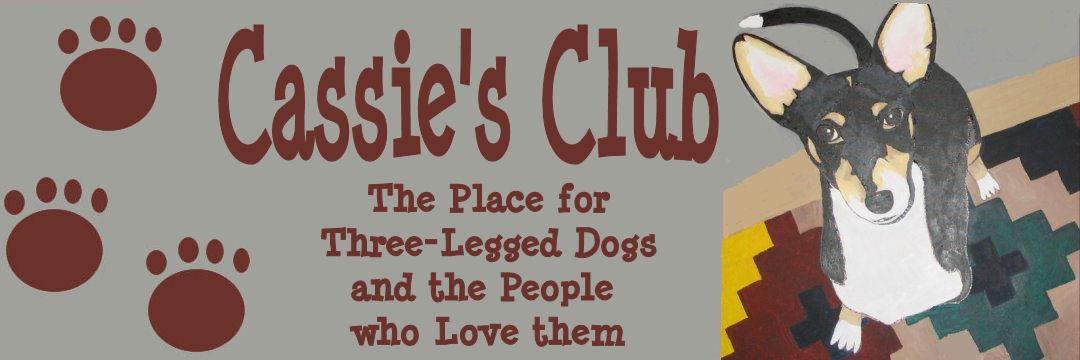|
Hannibal
This loving trooper passed away on 6/11/2004 at 6:15pm.
In honor of you, champ...He endured a lot and never lost his smile.
What an example for us as people to want to be like.
Thanks for the ride, Hannibal.
Stephanie Hyde
New York
Sunday July 23, 2006
UPDATE:
Limb amputation is a surgical procedure commonly performed in dogs and cats
to remove a diseased or injured limb, either front or rear.
Amputation may be a life saving procedure for animals that only minimally impacts
their comfort and quality of life.
Owners should have a clear understanding of why the surgery is being performed
and what can be expected afterwards. Pets function exceptionally well on three legs
and are able to run, walk, and play without pain or discomfort.
Pets do not suffer the psychological distress of losing a limb the same way a human does,
so it may be difficult for owners to understand how their pet will feel or act.
Vets have found amputations do not seem to slow animals down or even bother them very much.
Since dogs and cats are four-legged animals, they can get along really well on three legs.
Most animals will tolerate an amputation extremely well and have a really good quality of life
afterwards. The primary purpose of the limb is in movement.
Because pets do not need to perform fine motor skills, they easily adapt to having only three legs.
Most animals that have had amputations have probably already learned to walk on three legs
and owners may not realize this. Often, the pet may be relieved to have the painful leg removed
and may feel even better after the amputation, than it did before surgery.
Another aspect to consider is the long term effect of an amputation.
An early amputation may be more beneficial for your pet
than for it to go through multiple painful surgeries to save the leg.
Prior to general anesthesia, your vet may run blood work to check for other health problems.
Chest X-rays are often taken when tumors are present to determine if there is evidence
that the tumor has spread to the lungs.
If cancer is suspected, x-rays are taken of the limb, and typically a biopsy will be obtained
to confirm the diagnosis prior to amputation. In certain parts of the country,
some fungal bone lesions can mimic cancer on x-rays and therefore a bone biopsy is necessary
before such a radical surgical procedure is performed.
Pain medications are important both before, during and after amputation.
Your veterinarian will try to ensure your pet's comfort throughout the procedure.
Pain medication is usually given for a week or so after the surgery.
The majority of dogs are up and around the day following the amputation.
Some assistance may be necessary to help larger dogs outside, particularly if they are
overweight or were not lame before surgery.
In addition, after bringing your pet home, you can help your pet adapt more quickly
by providing quality food, lots of rest and comfortable bedding.
Make sure you supervise your pet especially when you first get home,
because it can slip and fall.
You may be concerned about how your dog will look or move around after an amputation.
If possible, have your veterinarian put you in contact with other pet owners
who have had the same concerns, but had the surgery performed nonetheless.
Such owners can assure you that dogs typically do extremely well on three legs.
It may also be helpful to see pictures of what front leg amputations and hind leg amputations
look like after surgery.
After surgery, there will be an incision that needs to be assessed daily for swelling,
redness or discharge. Contact your veterinarian if you have questions or concerns.
Stitches or staples need to be removed in 10-14 days.
Do not allow your pet to lick or chew at the surgical site.
An Elizabethan collar may be necessary to prevent this from occurring.
Tuesday July 25, 2006
|
|
Rabbit
This is my three-legged dog, named Rabbit.
I found him at a humane society in Golden Valley, MN about 1 1/2 years ago.
He was hit by a car when he was four months old and dumped at the shelter.
He still has his hip joint and wiggles it like crazy when you give him a good scratch
behind the ear. Rabbit is the most sweet and loving dog who has never let his handicap
hold him back from having fun!
Leah D. Falon
Monday July 24, 2006
|





